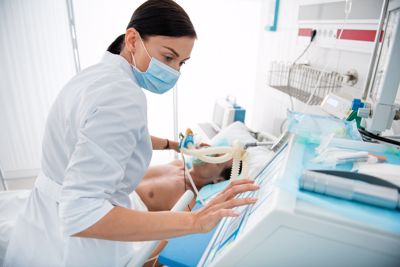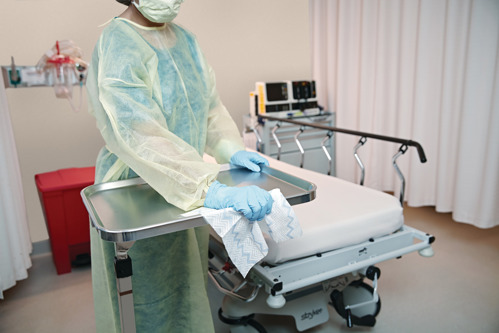
Healthcare-acquired infections (HAIs) are infections that occur at hospitals and other care facilities. Also known as nosocomial infections, they can worsen patient conditions and, in some cases, cause death.
HAIs also raise healthcare costs by increasing the rate of hospital readmissions and the need for additional treatment. For example, a patient with a mild condition may develop a serious infection that requires more time and resources to address.
In 2022-23, there were 988,000 hospitalisations (8.1% of total hospitalisations) in Australia that recorded a condition arising during the episode of care. However, because HAIs can be difficult to track, they often go unnoticed. It is up to healthcare administrators to ensure policies are in place to reduce the likelihood of infections spreading from patient to patient.
Infectious diseases are illnesses caused by various pathogens, such as bacteria, viruses, fungi and parasites. These diseases can spread from one individual to another, which makes them a significant concern in public health. The presence of an infectious agent in the body can lead to a range of health issues, from mild discomfort to severe conditions.
In a healthcare setting, infection control is crucial to prevent the spread of infectious diseases. Patients can become infected through various sources, including contaminated food, bodily fluids or contact with infected persons. The immune system plays a key role in defending against these germs, but susceptible hosts — those with weakened immune systems — are at higher risk. Effective disease control measures, including infection prevention protocols, are essential to protect both patients and healthcare workers.
Healthcare environments are prone to several types of infections. Bacterial infections like E. coli, staph, MRSA and C. diff are common and can lead to serious complications if not properly managed. Viral infections such as hepatitis B, HIV and influenza pose significant health risks. Additionally, fungal infections can occur, particularly in immunocompromised individuals. Other common types include urinary tract infections and pneumonia, which can significantly impact patient health. Understanding these common infectious diseases helps in implementing effective infection control strategies.
Infections can be transmitted through various methods, making infection prevention a multi-faceted approach.
Recognising these methods of disease transmission is vital for developing comprehensive infection control policies in healthcare settings.

Understanding the potential sources of infection within a healthcare facility is the first step to reducing the risk of HAIs. In healthcare circles, these are known as reservoirs of infection because they can hold different types of pathogens and microorganisms.
Maintenance personnel in healthcare facilities should know all potential reservoirs. Administrators should develop checklists for how to clean and maintain patient rooms and common areas. When maintaining patient rooms, cleaning staff may need one checklist for when a patient is occupying a room and another for after the patient is discharged.
In cases where a patient is known to have a highly infectious disease, stricter sanitisation procedures may be required.
Here are some examples of common sources of infection in a healthcare setting:
Patients, visitors, healthcare providers and facility staff may touch door handles multiple times each day, making them a primary reservoir of infections. Cleaning staff should wipe down door handles with microfibre cloths that can remove 99.9% of microbes, which act as a food source of live pathogens.
Dirty shoes and equipment can spread infectious pathogens from room to room. Floors should be washed with dust mops and damp mops to remove potential sources of infection. Likewise, spills should be cleaned and sanitised immediately using the proper spill kit. Cleaning materials used on bodily fluids should be disposed of in properly labelled containers.
Porous materials like bed linens, patient gowns, towels and window curtains can hold onto pathogens for longer periods. Used linens should be placed in laundry bags and brought directly to the laundry facilities for sanitisation. Soiled linens should be removed immediately to prevent pathogens from spreading around the patient's room.
Patient lavatories can be one of the biggest reservoirs of infectious pathogens. They should be cleaned daily after the patient is discharged. Cleaning personnel should use microfibre cloths to wipe down mirrors, sinks, faucets and all other surfaces. Waste containers should be emptied and any consumable supplies should be restocked.
Any medical equipment in a patient's room is a potential source of infection. Patient call buttons, monitors, blood pressure cuffs, etc., should be wiped down and disinfected after each use. Cleaning carts should be stocked with disposable microfibre cloths to wipe down and sanitise equipment.
Beds, chairs and cabinets are all high-touch objects that must be cleaned daily and after patient discharge. Visitors can unknowingly bring in pathogens from the outside world and deposit them on hospital furniture. Chairs in common areas should be cleaned regularly.
Most patient rooms contain a whiteboard and markers for noting important information. These objects can go unnoticed because they're not directly related to patient care. However, many people come in contact with these objects, including patients, visitors and healthcare providers. They should be wiped down daily.
Face masks, gloves and other PPE can be potential sources of infection. For example, if someone wearing gloves touches a reservoir and then touches a piece of furniture, pathogens may move from one surface to the other. All PPE should be disposed of or sanitised appropriately. Healthcare providers should dispose of their PPE in specially marked containers when working with patients with known infectious diseases.
Any person within a healthcare facility can be a potential vector of infection. Proper hand-washing techniques and wearing PPE are essential to reducing the potential impact of person-to-person interactions.
Preventing infectious diseases in healthcare settings is crucial, as well as relying on rigorous hand hygiene, proper use of PPE and diligent environmental cleaning to protect patients, healthcare workers and visitors.
Hand hygiene is the cornerstone of infection control. Adhering to the "5 moments" for hand hygiene helps reduce the transmission of germs and pathogens. This practice involves cleaning hands before and after patient contact, after contact with bodily fluids, before aseptic tasks and after touching patient surroundings.
Using PPE appropriately is essential to minimise exposure to infectious agents. Based on the risk of exposure to bodily fluids and infectious materials, healthcare workers should wear gloves, gowns, masks and eye protection. Proper donning and doffing techniques are critical to prevent self-contamination.
Environmental cleaning also plays a vital role in reducing the risk of HAIs. High-touch surfaces such as door handles, bed rails and medical equipment should be regularly disinfected to eliminate potential reservoirs of infection.
By implementing these infection control measures, healthcare facilities can significantly lower the risk of disease transmission and promote a safer environment for everyone.

Investing in the right cleaning supplies and products is vital for maintaining rigorous infection control in healthcare settings. High-quality cleaning solutions actively reduce the risk of infectious diseases, enhancing patient outcomes and boosting the facility's reputation.
Effective cleaning solutions improve patient health and cut unnecessary costs. They also elevate the facility's public image. Choosing superior cleaning products ensures a safer environment for patients, healthcare workers and visitors.
Learn more about Rubbermaid Commercial Products® healthcare cleaning solutions.